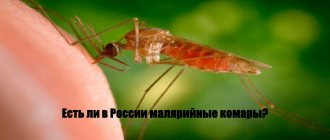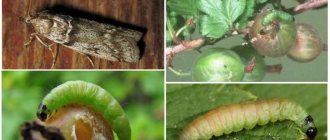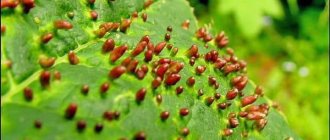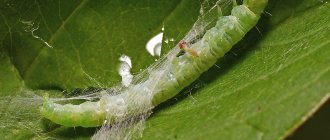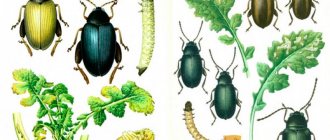Varieties and features of lifestyle
- Fact:
Modern scientists know about 9 thousand species of these insects. - Fact 2:
About 2 thousand are registered in our country. - Fact 3:
The name sawfly comes from the external similarity of the shape of the egg clutch with the surface of the saw. - Fact 4:
Regardless of species, sawflies have a common activity time.
Sawflies are very harmful insects that infect entire plantations of agricultural and forest coniferous plantations. This type of herbivorous pest is divided into many subspecies, each of which prefers to destroy a specific plant.
Description and photo
Modern scientists know about 9 thousand species of these insects. About 2 thousand are registered on the territory of our country. The name sawfly comes from the external similarity of the shape of the egg clutch with the surface of the saw. Certain categories of sawflies make the clutch much narrower than usual for these insects, which makes its penetration under the tree bark simpler and easier.
Larva
It's called a false caterpillar. It really looks a lot like the caterpillar of this beautiful winged creature. But there are also differences:
- Eyes. The larva has 2, the caterpillar has 6.
- Paws. Larvae – 6 or more pairs, caterpillars – no more than 5.
Sexually mature individuals
On the body, with a color depending on the species, a pair of double thin, rather long wings with coarse veins. The thoracic and abdominal sections are separated by a bridge, wider in width than in other hymenoptera, for example, the same bee.
Regardless of the species, sawflies have a common activity time. These are the spring and summer seasons. Reproduction occurs in autumn. If the weather is warm and dry, it is difficult to imagine better conditions for insect reproduction. The masonry is done on a coniferous bedding or directly in tree bark. Closer to frost, the larva penetrates the soil, wraps itself in a cocoon of cobwebs and waits for the onset of spring.
How to get rid of sawfly and its larvae
Chemical and biological agents
The first treatment with chemicals is carried out in the spring after the growth of young shoots, the second time is sprayed after 14 days.
Karbofos
Contact-intestinal insecticide that causes the death of the pest 3–4 hours after treatment. The dosage of the drug is 30 g per 4 liters of water.
For spraying 10 sq. m will require 2 liters of solution. It is used immediately after preparation, since the active substances lose their properties during storage. To avoid addiction, it is recommended to alternate this insecticide with other products.
Kinmiks
The drug acts on larvae and adults, paralyzes them and causes the death of the pest. The solution is prepared by mixing the contents of a 2.5 ml ampoule and 10 liters of water. Plants are sprayed within 3 hours after preparing the solution. The advantage of the insecticide is that it does not accumulate inside the fruits and does not spoil their taste.
Fufanon
Insectoacaricide of contact-intestinal action. For sawfly on different crops, dissolve 12 ml of the drug in 10 liters of water. Liquid consumption for treating trees is 2–5 liters per 1 tree, depending on age, for berry crops – 1.5 liters per 1 bush.
Lepidocide
Biological product for treating various plants against sawfly. The concentration of the product in 10 liters of water is 20–30 g. Trees are sprayed against each generation of sawfly 1–2 times with a break of 10 days, berry bushes – 2–3 times every 7–8 days. Vegetables are processed up to 5 times.
Traditional methods
In small areas, sawflies are destroyed manually. They are shaken off the trees 2–3 times a day by spreading film or burlap on the ground. The collected pests are then destroyed in a bucket of water.
When the pest is small in number and for prevention, various herbal solutions are used.
- 70 g of soda ash is dissolved in 10 liters of water, add 1 tbsp. l liquid soap and spray the plants.
- 50–100 g of crushed garlic is poured into 10 liters of water. The solution is stirred well, filtered and used immediately. You can also make this infusion from garlic. 30 g of crushed cloves are poured into 1 liter of water and left for 2 days in a dark place. Before processing, the infusion is filtered.
- Cut and slightly dried wormwood is finely chopped and filled with water in a 1:1 ratio. Leave for 1 day, then boil for 30 minutes. After cooling, the solution is filtered. For spraying, the concentrate is diluted with water in a 1:1 ratio.
- Horseradish leaves and petioles are finely chopped and placed in a bucket, filling 2/3 of the volume. The mixture is poured with water, stirred and left for 2 hours. Crushed horseradish roots can be used as a raw material. In this case, you will need 2 times less roots than leaves.
Birch sawfly
- The larva is light emerald green in color. Size ~ 4.5 cm. There is a thin black stripe along the back, with a yellowish border along the edges. The head is large, pale yellow. Lucky – 11 pairs. The period of activity is July-September. They feed exclusively on birch leaves.
- The adult insect is dark-breasted and dark-headed with an orange or brownish-red abdomen with highlights. Size – 2-2.5 cm. The antennae are club-shaped, black with bright orange ends. Transparent wings with dark edges. Food: birch leaves.
Control measures:
- Digging up an area under trees before hibernation.
- Manual collection and destruction of larvae and cocoons.
- Treatment of trees with chemicals (Chlorophos, Metaphos) in June-July.
Spruce sawfly
- The larva is almost coniferous, soft green in color. The eyes are black. The legs are sharp, 3 pairs at the beginning of the body and 7 (false) subsequent ones. Size – 1-1.5 cm. Food – young needles. In June they burrow into the forest floor of pine needles and grass to pupate.
- An adult is a small insect (5-6 mm). The color is black with yellow mouthparts, abdomen and wing veins. Endowed with the thinnest long antennae. The active period is April-June.
The spruce pest causes great damage to coniferous plantings. which greatly slows down their growth.
Control measures:
- Digging in the tree trunk area.
- Treatment with chemicals
Gooseberry sawfly (including yellow gooseberry)
- The larva is gray-blue, pale green (yellow ones with large growths or black spots). At the last stage of transformation, the caterpillar darkens and gets rid of its spots. 10 pairs of paws. Food: leaves of berry bush.
- An adult is gooseberry up to 7-8 mm, yellow – up to 6-7 mm. The wings are transparent, with black or brown markings. Food: leaves of currant and gooseberry bushes. Very gluttonous. From a distance, he brushes away a smaller copy of a wasp.
Active devouring of foliage ultimately leads to the death of a gooseberry or currant bush.
Control and prevention measures:
- Autumn digging of soil under a bush.
- Spring digging.
- Spraying with soapy tar solution.
- After flowering, treatment with pine needle or entobacterin extract.
- Treatment with chemicals (Chlorophos, anabasine sulfate).
Methods for controlling beetles and larvae
Any gardener and forestry worker is familiar with harmful insects. To understand that it is the sawfly that has taken over the trees, it is enough to take a close look at the crown of the tree. On the leaves, traces of the larvae's activity appear in the form of small paths and holes - mines, which are tunnels gnawed by voracious caterpillars. On conifers, the needles have convex places called galls.
After such lesions, the leaves and needles turn yellow and dry, and the tree is deprived of the normal functioning of photosynthesis processes. If you do not start to counteract the pest in time, the plants may die.
At the initial stage of infection of a small tree or shrub, you can try to collect the larvae by hand. Before you fight them with chemicals, you can first use folk remedies. Spray the crown of the tree with a solution of mustard, wormwood, tobacco or laundry soap. The same method is good as prevention. In advanced cases, when the number of larvae is too large, spraying with organophosphates, pyrethroids, and antiviral drugs will help. The most popular are:
- Chlorophos;
- Anabasine sulfate;
- Metaphos;
- Virin-diprion and others.
To prevent infection of neighboring plants, it is necessary to dig up the soil around the trunk of the diseased tree. To prevent a new wave of the next generation of sawflies, an adhesive ring is used. The trunk of the plant is coated with a special glue that does not lose its adhesive properties for a long time. Before overwintering, sawfly larvae will move down to the ground and become trapped.
Grain sawfly (stem sawfly)
- The larva is faded yellow, without legs. size – 12-14 mm. Light brown head. The end of the body is decorated with a spiked process.
- An adult is a black creature with a narrow body up to 1 cm. On the back there are shiny stripes or spots of pale yellow color. The paws are black, the first pair is yellow.
Pests feed on grain crops (wheat, rye, barley, oats), eating away the pulp of the stem. The spikelet dries out and breaks during harvesting.
Control measures:
- Deep plowing of plowed land.
- Stubble peeling (after harvesting the ear).
- Separate harvest.
- Treatment with insecticides (Break, Borey).
- Regular weeding.
Common pine sawfly
- The larva is pale yellow with a brown or black head. Size – 2.5-2.9 cm. Paws – 8 pairs. Overwinters in the soil under a tree.
- Adult insect. The female has a dark yellow or brown body with black sternum and dorsal markings. Size – 10 mm. A short mustache resembling a file. The male is black in color, thinner, has feathery whiskers, and yellow paws.
They feed on pine needles, completely destroying them. The tree weakens and becomes vulnerable to other pests and infections. Crimean pine is least susceptible to attack by the pine sawfly.
Control measures:
- Spraying with insecticides.
- Attracting birds.
- Breeding an anthill under a tree.
Rapeseed sawfly
- The larva is black, the sides are pale green. Size – 2.5 cm.
- An adult individual has an orange elongated body, a black head and the same mustache. Size – 6-8 mm. Part of the paws, sternum and the edge of the wing are also shiny black.
Harmful to cabbage species (rapeseed, rutabaga, radish, turnip, radish, turnip).
Control measures:
- Autumn deep plowing of the soil.
- Timely weeding.
- Treatment with chemicals (for example, Actellik).
Damage to crops
Although these pests are very small in size, they are capable of causing enormous damage. There may be 2-3 larvae per square meter. Rapeseed sawflies prefer shoots of radish, rapeseed, mustard, rutabaga and cabbage.
The first generation of rapeseed sawfly larvae are especially harmful.
The main diet of these pests are buds, leaf pulp and young pods. At the same time, rapeseed sawflies eat up the leaves almost completely; after these pests, only cuttings of the leaves remain. After exposure to sawflies, the shoots dry out, fruits do not form, and the yield is significantly reduced. Rapeseed sawflies pose a particular threat to rapeseed and turnips; sometimes they destroy 80-95% of the crop.
If you find an error, please select a piece of text and press Ctrl+Enter.
Apple sawfly
- The larva is faded yellow. Size – 1 cm. Legs – 10 pairs, the first 3 – thin and long. The head turns from black to brownish with age. Food: fruits of the tree.
- The adult pest is brown or black. Size – 6-7 mm. The chest is black, the wing is matte-transparent, dark, the paws are yellow. Food: nectar from a blossoming apple tree.
Due to the fault of the apple sawfly, the ovary falls off; one larva destroys 2-6 apples in its short life.
Control measures:
- Digging in the trunk circle and row spacing.
- Spraying the soil with dust during the flowering period.
- Treatment of set fruits with chemicals (Karbofos, DDT).
Spreading
Horntail Urocerus gigas
Distributed everywhere[3]. Sawflies are most abundantly represented in the temperate and northern latitudes of the Holarctic, where they are comparable in biomass, and in the north they significantly exceed Lepidoptera. For example, in the fauna of Finland there are over 700 species of Symphyta (Viitasaari, Vikberg, 1985), and in Russia there are about 2000 species.
Of the 14 modern families, Anaxyelidae (Syntexidae) with 1 recent species from the USA (California), as well as Pergidae (Pterygophoridae); the latter are distributed mainly in Australia and South America. Of the remaining families, Megalodontesidae is endemic to the Palearctic; Blasticotomidae are also known now only in Eurasia, 1 species was described from the Miocene of North America.
Distribution of species by zoogeographical regions (2008):
- Palaearctic - 4014
- Nearctic - 1245
- Oriental region - 1608
- Neotropics - 925
- Afrotropics – 352
- Australia - 230
- Fossil species - 381
Single weaver sawfly
- The larva is gray-green, with a dark dorsal stripe. Size – up to 2.5 cm. 6 pairs of paws and 1 pair of false paws.
- An adult insect has a black body, yellowish belly, black mustache and head. Size – 13-17 mm. The wings are pale yellow, slightly transparent.
They form nests of cobwebs on the branches of cone-shaped pine trees. They feed on pine needles.
Control measures:
- Destruction of spider nests.
- Treatment with chemicals.
- Digging up the soil.
Developmental stages and nutrition
When an adult beetle emerges from a pupa in the spring, it immediately begins to consume soft, tender greenery. Having gained strength and nutrients, sawflies mate and prepare to give birth to offspring. The female pest chooses a suitable place for laying. Usually this is a tree leaf or pine needles. By making a microscopic cut with its ovipositor, the insect lays its eggs in a small cavity, where they remain for about 10 days. Then larvae emerge from them - small false caterpillars. They are called this because they have a different number of eyes and limbs than most species of caterpillars.
Interesting!
When in danger, the sawfly beetle larva begins to behave unusually - it simultaneously raises its hind and forelimbs. Certain species secrete a poisonous liquid from the mouth. These secretions can cause an allergic reaction on human skin.
Light green or yellow beetle larvae consume soft plant tissues with great appetite, and can sometimes move onto young shoots and tree bark. They crawl in flocks from one branch to another, leaving behind damaged leaves, rolled up or yellowed and chewed needles. In warm summer conditions and an abundance of plant food, the larvae reach a length of more than 4 cm by August or September and are ready to pupate. To do this, they find a secluded place on a tree or crawl down the trunk to burrow into fallen leaves.
Further development of the larva has two paths:
- After 2-3 weeks, an imago emerges from the pupa, ready for a new development cycle. Thus, during a season, a forest area can be damaged twice by the activity of these insects.
- The sawfly larva may sense the approaching cold weather and remain in the pupal stage until next summer. And in case of unfavorable conditions, the pupa remains in the ground for up to 2 years, waiting for the arrival of the long-awaited warmth.
sawfly beetle
